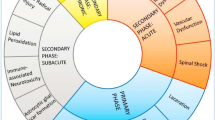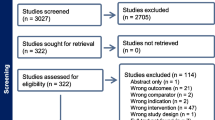Abstract
Compression may induce morphological and neurophysiological changes in nerve roots. However, it has also been demonstrated experimentally that nucleus pulposus, without any compression, may induce similar changes when applied epidurally. The present study was undertaken to examine the morphological and functional effects of autologous nucleus pulposus and the combination of nucleus pulposus and compression in a pig model. Nucleus pulposus from a lumbar disc in the same animal was applied epidurally around the first sacral nerve root in the pig, with or without a specially designed constrictor. After 1 week, nerve root conduction velocity was determined in the exposed and in the contralateral control nerve root by local electrical stimulation and EMG recordings in the back muscles. Nerve root specimens were processed for blinded light-microscopic evaluation. There was a significant reduction in nerve conduction velocity for all exposed nerve roots as well as contralateral control nerve roots when nucleus pulposus had been applied. There were no statistically significant differences between the nerve conduction velocities recorded following the combined application of nucleus pulposus and compression and those recorded after application of nucleus pulposus alone. The reductions were similar to the reduction induced by the constrictor per se, as seen in a previous study. In all series there was also a decrease in conduction velocity in the control nerve roots, in contrast to previous studies. Light microscopy demonstrated axonal changes only in nerve roots exposed to the constrictor. In conclusion, both epidural nucleus pulposus and compression may induce a significant reduction in nerve conduction velocity. The combination, however, of these two agents does not increase the magnitude of such dysfunction. The potency of nucleus pulposus to induce changes in nerve roots after epidural application was further indicated by the fact that reduction in nerve conduction velocity also occurred in the contralateral control nerve roots in this series. The histological data suggest that axonal injury can not alone explain the reduction in nerve conduction velocity, and that the morphological basis for the functional changes must be sought at the subcellular level.
Similar content being viewed by others
References
Cornefjord M, Olmarker K, Farley DB, Weinstein JN, Rydevik B (1995) Neuropeptide changes in compressed spinal nerve roots. Spine 20:670–673
Cornefjord M, Sato K, Olmarker K, Rydevik B, Nordborg C (1995) A model for chronic nerve root compression studies; presentation of a porcine model for controlled, slow-onset compression with analyses of compression onset rate, anatomical aspects, morphological and neurophysiologic effects. Manuscript. Submitted to Spine
Guth BD, Heusch G, Seitelberg R, Ross J Jr (1987a) Mechanism of beneficial effect of β-adrenergic blockade on exercise-induced myocardial ischemia in conscious dogs. Circ Res 60: 738–746
Guth BD, Heusch G, Seitelberg R, Ross Jr J (1987b) Elimination of exercise-induced regional myocardial dysfunction by a bradycardiac agent in dogs with chronic coronary stenosis. Circulation 75:661–669
Inou T, Tomoike H, Watanabe K, Kikuchi Y, Mizukami M, Kurozumi T, Nakamura M (1980) A newly developed X-ray transparent ameroid constrictor for study on progression of gradual coronary stenosis. Basic Res Cardiol 75:537–543
Karnovsky MJ (1965) A formaldehyde-glutaraldehyde fixative of high osmolality for use in electron microscopy. J Cell Biol 27: 137A
Matsuzaki M, Guth B, Tajimi T, Kemper WS, Ross J Jr (1985) Effect of the combination of diltiazem and atenolol on exercise-induced regional myocardial ischemia in conscious dogs. Circulation 72:233–243
Nachemson A (1992) Symposium on “Newest knowledge on low-back pain”. (Editorial) Clin Orthop 279: 8–20
Olmarker K, Rydevik B, Holm S (1989) Edema formation in spinal nerve roots induced by experimental, graded compression. An experimental study on the porcine cauda equina with special reference to differences in effects between rapid and slow onset of compression. Spine 14:569–573
Olmarker K, Holm S, Rydevik B (1990) Importance of compression onset rate for the degree of impairment of impulse propagation in experimental compression injury of the pig cauda equina. Spine 15:416–419
Olmarker K (1991) Spinal nerve root compression. Nutrition and function of the porcine cauda equina compressed in vivo. Acta Orthop Scan [Suppl. 242]
Olmarker K, Rydevik (1992) Single versus double level compression. An experimental study on the porcine cauda equina with analyses of nerve impulse conduction properties. Clin Orthop 279:35–39
Olmarker, Rydevik B, Nordborg C (1993) Autologous nucleus pulposus induces neurophysiologic and histologic changes in porcine cauda equina nerve roots. Spine 18:1425–1432
Olmarker K, Larsson K, Nordborg C, Rydevik B (1996) Ultrastructural changes in spinal nerve roots induced by autologous nucleus pulposus. Spine 21:411–414
Olmarker K (1995) Mechanical and biochemical injury of spinal nerve roots in an experimental perspective. Presented at the NIH/AAOS workshop: New horizons in low back pain, San Diego, 1–4 November
Pedowitz RA, Garfin SR, Hargens AR, Swenson MR, Myers RR, Massie JB, Rydevik BL (1992) Effects of magnitude and duration of compression on spinal nerve root conduction. Spine 17: 194–199
Richardson KC, Jarett L, Finke EH (1960) Embedding in epoxy resins for ultrathin sectioning in electron microscopy. Stain Technol 35:313–323
Rydevik B, Brown MD, Lundborg G (1984) Pathoanatomy and pathophysiology of nerve root compression. Spine 9:7–15
Sato K, Olmarker K, Cornefjord M, Rydevik B, Kikuchi S (1994) Changes of intraradicular blood flow in chronic nerve root compression. An experimental study on pigs. Neuroorthopaedics 16:1–7
Vineberg A, Mahanti B, Litvak J (1960) Experimental gradual coronary artery constriction by ameroid constrictors. Surgery 47:765–771
Author information
Authors and Affiliations
Rights and permissions
About this article
Cite this article
Cornefjord, M., Olmarker, K., Rydevik, B. et al. Mechanical and biochemical injury of spinal nerve roots: a morphological and neurophysiological study. Eur Spine J 5, 187–192 (1996). https://doi.org/10.1007/BF00395512
Received:
Accepted:
Issue Date:
DOI: https://doi.org/10.1007/BF00395512




